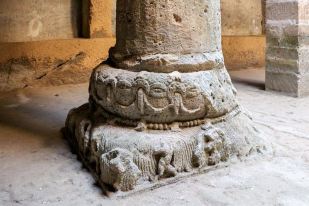It is this fort which gives the city it’s name: Juna (Old) garh (fort)

It is said to be over 2300 years old. It’s a majestic fort though only a few of its buildings remain today.

What does remain and a big draw are the 2nd -3rd century AD Buddhist caves located at one end of the Fort. Buddhism flourished in these parts in ancient times. These were carved when Junagadh was the capital of the Kshatraparulers.
There are three major Buddhist cave groups here. The other two being the Baba Pyaare and Khapra Kodiya Caves.

These monastic caves are carved out of rock. Imagine the dedication and skill of a Buddhist monk armed with primitive instruments and piety carving and cutting his way down into the mountain, creating a piece of wonder in the process!

These caves have influence of Satvahana ( a 1st century BCE to 2nd century AD empire based in the Deccan) architecture with combination of Graeco- Scythian style.

According to ASI “The cave group is in three tiers, with all members of each galleries shown in semi-relief, but only two storeys having regular floors.

They were built for meditation and in such a way that they were airy and well-lit
The upper floor has a deep tank, covered on three sides with verandahs.


It’s the lower floor which shows signs of the spectacular workmanship with exquisite pillars and remnants of carving on the walls

Carved pillar capitals

These are carved from the rock!!

These caves have an assembly hall and cell for meditation.
A window

in the walls on the north-east and west sides are stone bench-recesses, divided into long compartments

Archival photo 1900 British Library Curzon Collection.

Remnants of carvings

Holes in the pillars for holding mashals for light

Water bodies and rain water collection

Rain water harvesting seems to have been a very important aspect of their lives and obviously survival

Carved Pillar bases

In the ‘Report on the Antiquities of Kathiawad and Kachh of 1874-75’, Burgess wrote, “The Uparkot or upper fort of Junagadh, is probably a rich mine of antiquities. It seems to have been the citadel of the old city, where the lieutenants of the great Asoka, and still later, of the Gupta kings lived…About the first time I visited Junagadh in 1869, some rock-cut apartments were discovered at the bottom of a descent on the north of the Jami Masjid. They are of considerable interest, for, though much defaced, they manifest a high style of art. Few bases, for examples, could be found anywhere to excel in beauty of design and richness of carvings those of the six pillars in the lower hall.”
Gallery:



